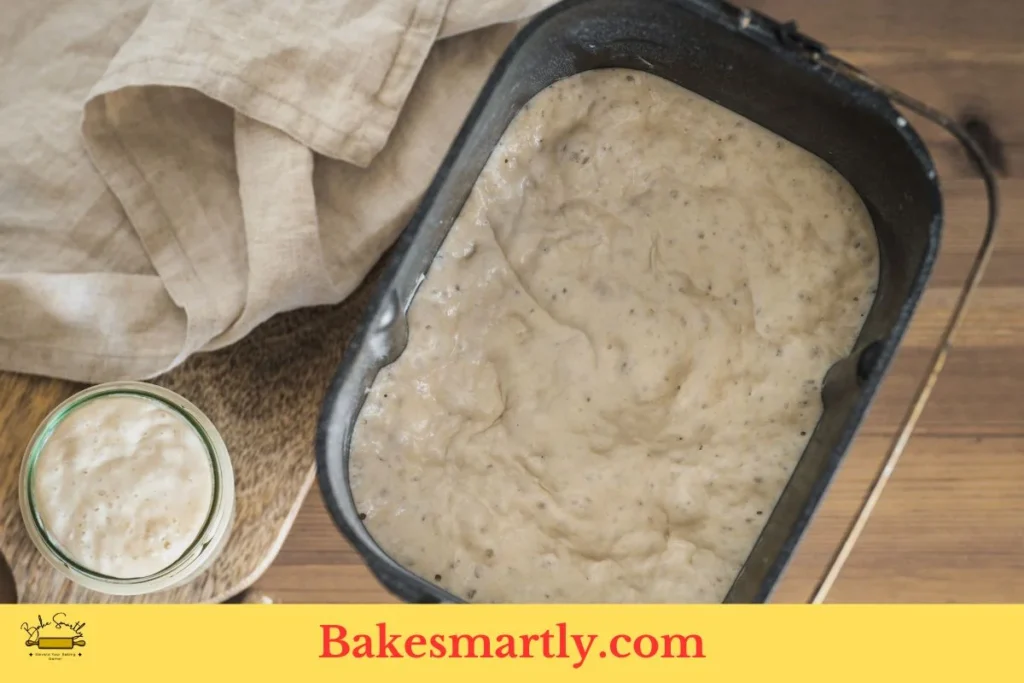
Why Does a Sourdough Starter Taste Bitter | Truth Revealed
Sourdough bread is really popular because it tastes unique and tangy. It gets its special flavor from a mix of yeast and bacteria living together in flour and water. But here’s a question some people wonder about when they bake with sourdough: “Why Does a Sourdough Starter Taste Bitter?”
In this blog post, we’ll find out why this happens and what makes sourdough taste bitter.
Table of Contents
ToggleFactors that Contribute to a Bitter Taste in Sourdough Starter
A lot of folks, including experienced bakers, often run into a problem with sourdough bread tasting bitter. In this section, we’ll break down the different things that make sourdough bread turn bitter and share some tips for making sure your homemade bread tastes just right
Ingredient Quality
The foundation of a great sourdough starter, and ultimately bread, is the quality of your ingredients. If you’re experiencing bitterness in your sourdough, one of the first aspects to scrutinize is the flour and water you use.
- Flour: The type and quality of flour you use can significantly impact the flavor of your sourdough starter. Some flours inherently have a bitter taste due to their natural composition. Rye flour, for instance, can introduce a bitter edge to your starter. If you prefer a milder flavor, consider experimenting with different flours to find the one that best suits your palate. All-purpose or bread flour is often a safe bet for a balanced taste.
- Water: Water quality is another vital element in sourdough baking. If your tap water is chlorinated, it can impart unwanted flavors and contribute to bitterness. Chlorine can hinder the fermentation process, leading to off-flavors. To resolve this, use filtered or dechlorinated water, which provides a clean canvas for your starter’s growth.
Fermentation Temperature
The temperature at which your sourdough starter ferments plays a pivotal role in shaping its flavor profile.
Extreme temperatures, whether too hot or too cold, can stress the natural yeasts and bacteria, leading to bitterness. Maintaining a stable and moderate temperature is essential for a harmonious fermentation process.
- Cold Fermentation: If your sourdough starter is exposed to cold temperatures, it may become sluggish, leading to a lackluster and sometimes bitter taste. During cold seasons, it’s crucial to provide a warm and draft-free environment for your starter to thrive. A consistent temperature between 70-75°F (21-24°C) is ideal for most sourdough starters.
- Overheating: On the other hand, overheating can push the fermentation process into overdrive. An accelerated fermentation can result in excessive acidity, contributing to bitterness. It’s crucial to avoid overheating your starter, especially during the warm summer months. Keeping your starter away from direct sunlight and extreme heat sources is a simple yet effective measure to maintain a balanced flavor.
Over-Acidity
Sourdough starters naturally contain lactic acid bacteria, which contribute to their characteristic tangy flavor.
However, an excessive buildup of acidity can lead to bitterness. It’s crucial to strike a balance between the acidity and other flavor elements in your sourdough starter.

- Regular Feeding: To manage acidity levels, it’s important to feed your starter on a regular schedule. Feeding your starter with fresh flour and water dilutes the acidity and refreshes the microbial community. A well-fed starter is not only healthier but also less likely to develop a bitter taste.
- Starter Maintenance: If you notice that your starter has become too acidic, you can perform a series of feedings at shorter intervals. Gradually, the acidity will decrease, and your starter will regain a more pleasant flavor profile. This process may take a few days, but it’s an effective way to restore balance.
Neglect and Poor Feeding
A common reason for sourdough bitterness is neglect. If you forget to feed your starter or maintain a consistent feeding schedule, the microbial balance can be disrupted, resulting in sour and unpleasant flavors.
- Regular Feeding: Neglecting your starter by not feeding it regularly can lead to bitterness. A well-fed starter is a happy starter. Establishing a routine where you feed your starter at the same time each day or every 12 hours ensures that it remains vibrant and maintains a balanced flavor.
- Discarding Excess: Remember to discard a portion of your starter before each feeding. This not only maintains a manageable quantity but also ensures that you’re working with the youngest and freshest microbial population, which contributes to a more pleasant taste.
Contaminated Utensils
The cleanliness of your utensils and containers is another factor that can influence the taste of your sourdough starter. Using dirty or soap-contaminated utensils when feeding your starter can introduce unwanted elements, leading to bitterness.
- Clean Tools: Always use clean and sanitized utensils when working with your sourdough starter. Avoid using soap to clean your containers, as even a trace of soap residue can negatively affect your starter’s flavor. Rinsing with hot water and thorough drying is sufficient.

Techniques to Reduce Bitterness in Sourdough Starter
Sourdough baking is an art that can yield a wide range of flavors, from mild and slightly tangy to intensely sour. If your sourdough starter has taken a bitter turn, don’t fret; there are techniques you can employ to reduce and prevent bitterness.
Here are some effective methods to help you achieve that delightful, well-balanced flavor in your sourdough.
Controlled Fermentation
Bitterness in sourdough often stems from over-fermentation. To manage this, maintain a consistent feeding schedule. By regularly refreshing your starter with fresh flour and water, you can dilute excessive acidity and prevent bitterness from taking hold.
Avoid leaving your starter unattended for extended periods, especially in hot weather, as this can lead to rapid fermentation and an undesirable taste.
Flour Selection
The type of flour you use plays a significant role in the flavor of your sourdough starter. If you’re aiming for a milder taste, consider using all-purpose or bread flour.
These flours are less likely to introduce bitterness compared to whole-grain or rye flours, which have distinct and potentially bitter flavor profiles. You can experiment with different flours to achieve the taste that best suits your preferences.
Balanced Hydration
Adjusting the hydration level of your starter can help control bitterness. A higher hydration starter (with more water) tends to ferment faster and can develop more acidity, potentially leading to bitterness.
Reducing the hydration slightly, making your starter thicker, can slow down fermentation and balance the flavor. Aim for a hydration level of around 100% for a manageable and well-balanced starter.
Lower Feeding Ratio
Another technique to combat bitterness is to lower the feeding ratio temporarily. If your starter has become extremely bitter, reduce the amount of old starter used in each feeding.
This slows down the fermentation process, giving the microbes in your starter a chance to adjust and produce fewer bitter compounds. Gradually return to the regular feeding ratio as the bitterness subsides.
Temperature Control
Keeping your starter at a moderate and consistent temperature is essential to avoid excessive bitterness. During cold weather, provide a warm and draft-free environment for your starter to flourish.
In hot climates, consider relocating your starter to a cooler area or using cooler water during feedings to slow down the fermentation process and maintain a balanced flavor.
Taste Testing
Don’t hesitate to taste your starter during the fermentation process. Regularly sampling it can help you catch bitterness early. If you notice a growing bitterness, take steps to adjust your feeding schedule, flour type, or hydration to bring the flavor back to your desired profile.
Why Does a Sourdough Starter Taste Bitter | Final Thoughts
In conclusion, understanding and managing the factors that contribute to a bitter taste in your sourdough starter is essential for achieving that delightful, well-balanced flavor.
Quality ingredients, including the choice of flour and water, play a critical role. Maintaining the right fermentation temperature, preventing over-acidity, and ensuring regular feeding and starter maintenance are key steps in the process.
Keeping your utensils clean and employing specific techniques such as controlled fermentation, flour selection, balanced hydration, and lower feeding ratios can all help combat bitterness. Ultimately, by applying these strategies, you can enjoy the unique and tangy goodness of sourdough bread without the unwelcome bitterness. Happy baking!
Lindsey Mackenzie
About me
Hi there! I’m Lindsey Mackenzie, the founder of Bake Smartly. Baking has been my passion since childhood, growing up in my father’s bakery. With Bake Smartly, I’m excited to share my love for all things sweet and savory. Join me on this delicious journey as we whip up scrumptious treats and sprinkle joy into every bite!






